Some food knowledge travels serenely, passing from generation to generation without any fuss. Everyone has the ingredients and instructions written down safely somewhere, or an aunt or two knows how to make that particular dish. But some recipes just vanish. We all remember a dish we ate and loved and who made the best version, but no one remembered to write down the recipe, or learn how to make it. These dishes are often the source of much regret-filled discussion at family gatherings, everyone wondering how on earth they could have let a gem of a recipe slip away into oblivion. 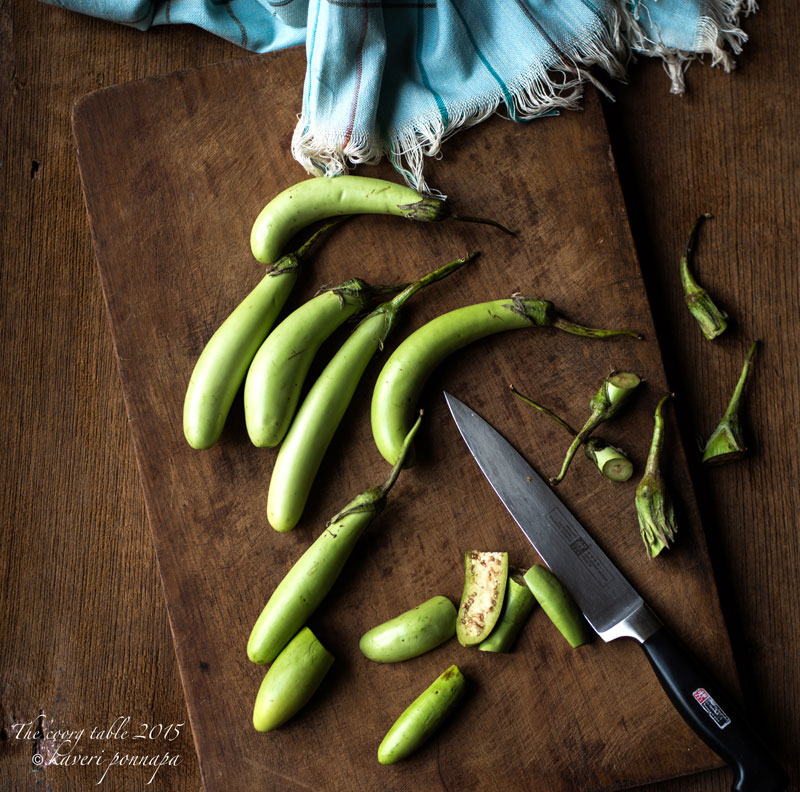 An avid recipe collector since my teens, over the years I stashed away so many of them that even I didn’t know how many I had. Although I cook every day and leaf my way through the piles of hand written pages and scraps of paper that have accumulated over the years, they still surprise me by falling out of folders and from between the pages of books –sheets of paper, sometimes worn so thin that the ink has seeped through onto the other side, presenting a smudgy, blurred version of the recipe. But there’s nothing wrong with the taste when you follow the instructions and cook the dish.
An avid recipe collector since my teens, over the years I stashed away so many of them that even I didn’t know how many I had. Although I cook every day and leaf my way through the piles of hand written pages and scraps of paper that have accumulated over the years, they still surprise me by falling out of folders and from between the pages of books –sheets of paper, sometimes worn so thin that the ink has seeped through onto the other side, presenting a smudgy, blurred version of the recipe. But there’s nothing wrong with the taste when you follow the instructions and cook the dish.  There were a few that slipped away, though, and one of them was my mother-in-law’s brinjal pickle. It was always made in smallish quantities. I imagine the shelf life was not too long: I never found out, because it always vanished very quickly. Brinjals –we never called them aubergines, or eggplants –are ideally suited to pickling in spices. Their soft, spongy texture is perfect for absorbing the flavours of spice. They simply guzzle oil, as anyone who has fried them knows, but that’s what turns them soft and velvety, to be loved, mashed into hot white rice, or squashed into an akki otti or chappati. It is such a mundane vegetable, that we take it entirely for granted, often ignoring it’s hidden qualities that make it such an asset in livening up everyday cooking. Brinjal pickle is one of those ordinary sort of recipes that makes use of whatever is easily, inexpensively available to turn out something absolutely delicious, the kind of kitchen genius with which Coorg women are so gifted.
There were a few that slipped away, though, and one of them was my mother-in-law’s brinjal pickle. It was always made in smallish quantities. I imagine the shelf life was not too long: I never found out, because it always vanished very quickly. Brinjals –we never called them aubergines, or eggplants –are ideally suited to pickling in spices. Their soft, spongy texture is perfect for absorbing the flavours of spice. They simply guzzle oil, as anyone who has fried them knows, but that’s what turns them soft and velvety, to be loved, mashed into hot white rice, or squashed into an akki otti or chappati. It is such a mundane vegetable, that we take it entirely for granted, often ignoring it’s hidden qualities that make it such an asset in livening up everyday cooking. Brinjal pickle is one of those ordinary sort of recipes that makes use of whatever is easily, inexpensively available to turn out something absolutely delicious, the kind of kitchen genius with which Coorg women are so gifted.  I had forgotten about brinjal pickle for years until one day, a regular reader and great supporter of The Coorg Table® wrote in with his mother’s recipe for it. It was so good, he said, that even confirmed brinjal haters mistake it for something better, and eat it with enthusiasm. So, with a sample kindly shared by his mother, I set about making a small batch, following her recipe, and trying at the same time to recall the taste of the pickle I had eaten so many years ago.
I had forgotten about brinjal pickle for years until one day, a regular reader and great supporter of The Coorg Table® wrote in with his mother’s recipe for it. It was so good, he said, that even confirmed brinjal haters mistake it for something better, and eat it with enthusiasm. So, with a sample kindly shared by his mother, I set about making a small batch, following her recipe, and trying at the same time to recall the taste of the pickle I had eaten so many years ago. 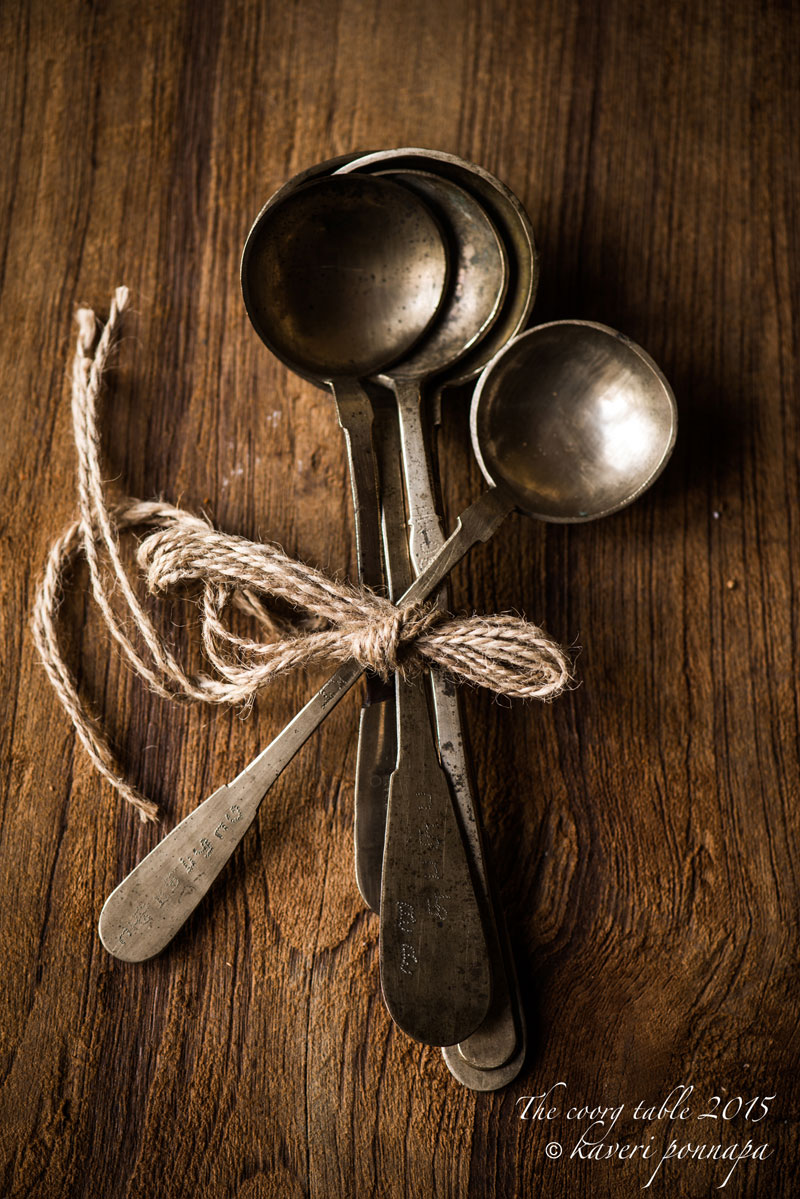 Chetan Bopanna’s mother had used the long, slim, light green brinjals, while my mother-in-law had used the purple ones. But there was no doubt about the taste. This was the pickle: sharp, richly coloured, with butter soft pieces of brinjal coated in a spice paste. The trial batch was eaten up so quickly that I had to put off posting on my blog, and make some more to be photographed. It was also one of the simplest, most undemanding pickles I had ever made. Salt and those familiar dry-roasted Coorg spices did their work effortlessly; the deep fried pieces of brinjal sank comfortably into a cushion of oil and spice paste, made sharp with vinegar. A faint bitterness from toasted fenugreek and sweetness from sugar added layers of their own.
Chetan Bopanna’s mother had used the long, slim, light green brinjals, while my mother-in-law had used the purple ones. But there was no doubt about the taste. This was the pickle: sharp, richly coloured, with butter soft pieces of brinjal coated in a spice paste. The trial batch was eaten up so quickly that I had to put off posting on my blog, and make some more to be photographed. It was also one of the simplest, most undemanding pickles I had ever made. Salt and those familiar dry-roasted Coorg spices did their work effortlessly; the deep fried pieces of brinjal sank comfortably into a cushion of oil and spice paste, made sharp with vinegar. A faint bitterness from toasted fenugreek and sweetness from sugar added layers of their own. 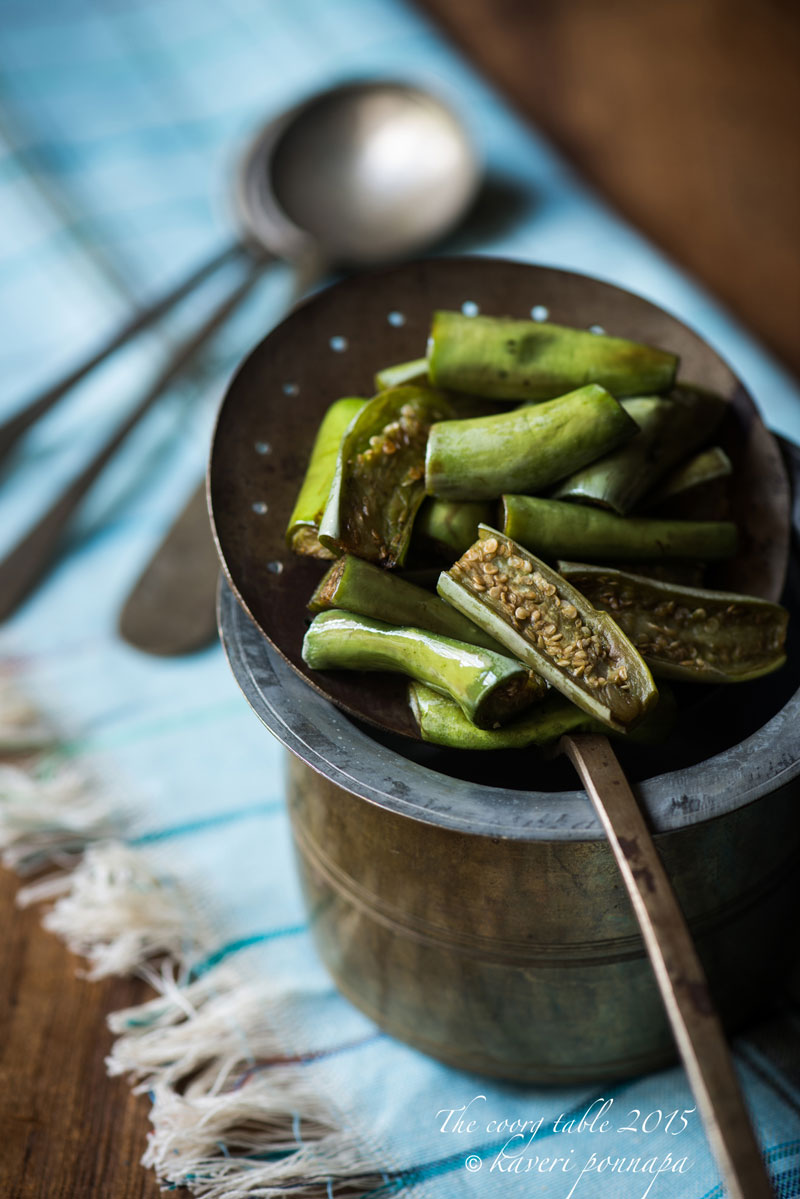 I don’t want to say much more about this pickle, except that I know that there will always be a bottle in my kitchen from now on. I doubt if I am going to bother doing much research into its shelf life though, considering the speed at which it disappears each time it is made. I have Padeyanda Rathi Bopanna to thank, for restoring a lost recipe to my collection.
I don’t want to say much more about this pickle, except that I know that there will always be a bottle in my kitchen from now on. I doubt if I am going to bother doing much research into its shelf life though, considering the speed at which it disappears each time it is made. I have Padeyanda Rathi Bopanna to thank, for restoring a lost recipe to my collection. 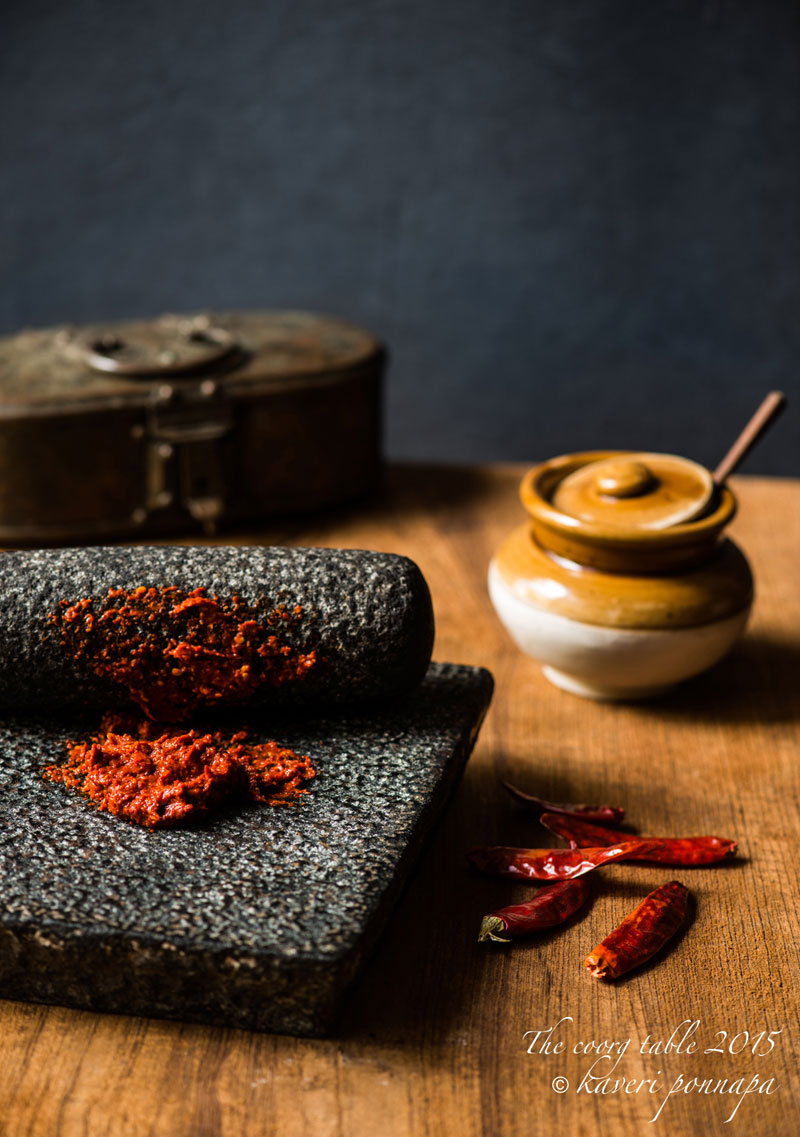
Bainay Para
Coorg Brinjal Pickle
Ingredients:
- 250 gms slim green brinjals
- 2 cups oil for deep-frying
- ¼ tsp fenugreek seeds
- 1 tsp mustard seeds
- 2 entire pods garlic, peeled
- 2 cloves
- 1 inch cinnamon
- Approximately 50 gms dried red chillis, a mixture of Bedagi & Guntoor, depending on the spice levels you want in your pickle.
- 1 cup brine made with rock salt, and allowed to cool.
- ¼ cup white vinegar
- 2 tbsp sugar
Method:
- Make a brine solution of 1 cup of water. Allow to cool.
- Wash and pat dry the brinjals, and trim away the tops.
- Slice the brinjal in half lengthwise, and then cut each half into approximately 1 inch pieces.
- Deep fry the pieces of brinjal in oil until the skin turns colour, and they are softened.
- Dry roast the fenugreek seeds, mustard seeds, cloves, cinnamon, dried red chillis and garlic on a tava, or in a khadai.
- Using just enough of the brine to make a thick paste, grind the dry-roasted spices to a smooth paste.
- Mix the spice paste into the fried brinjals.
- Dissolve the sugar in the vinegar, and add to the pickle.
- Mix thoroughly, and top with the remaining oil, and spoon into a sterilized jar.
Cook’s Note : This pickle is ready to eat almost as soon as it is made. A few days to allow the spices to settle works well. You can increase or reduce to the quantity of the dried red chillis that you use according to taste.
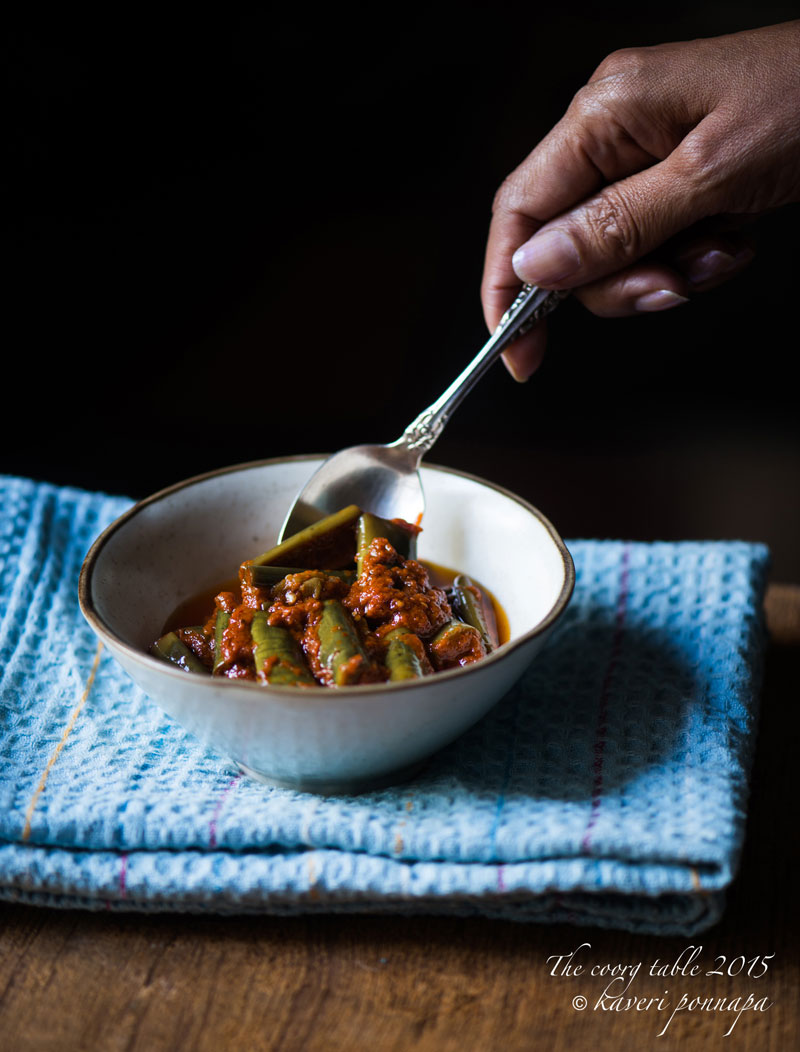
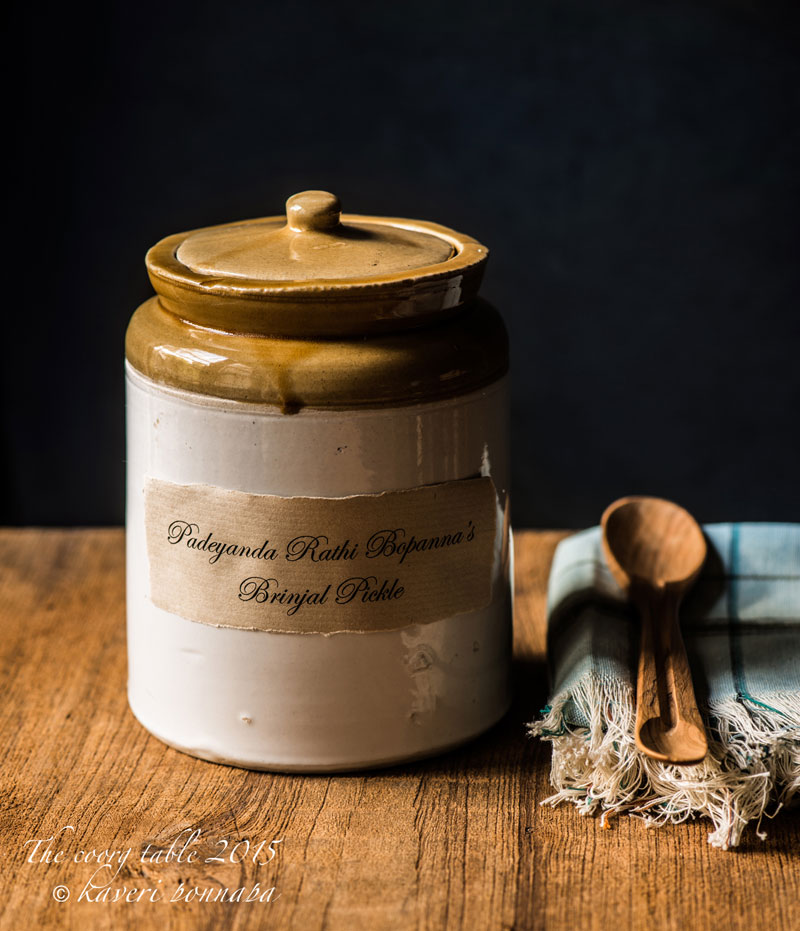
Image Credits: Nithin Sagi
All Food Styling: Kaveri Ponnapa
Thank you for visiting this page. If you read something that you enjoy, or see an image that you like, please take a moment to write a response. Do look out for the recipes of all the food featured here in my upcoming cookbook.

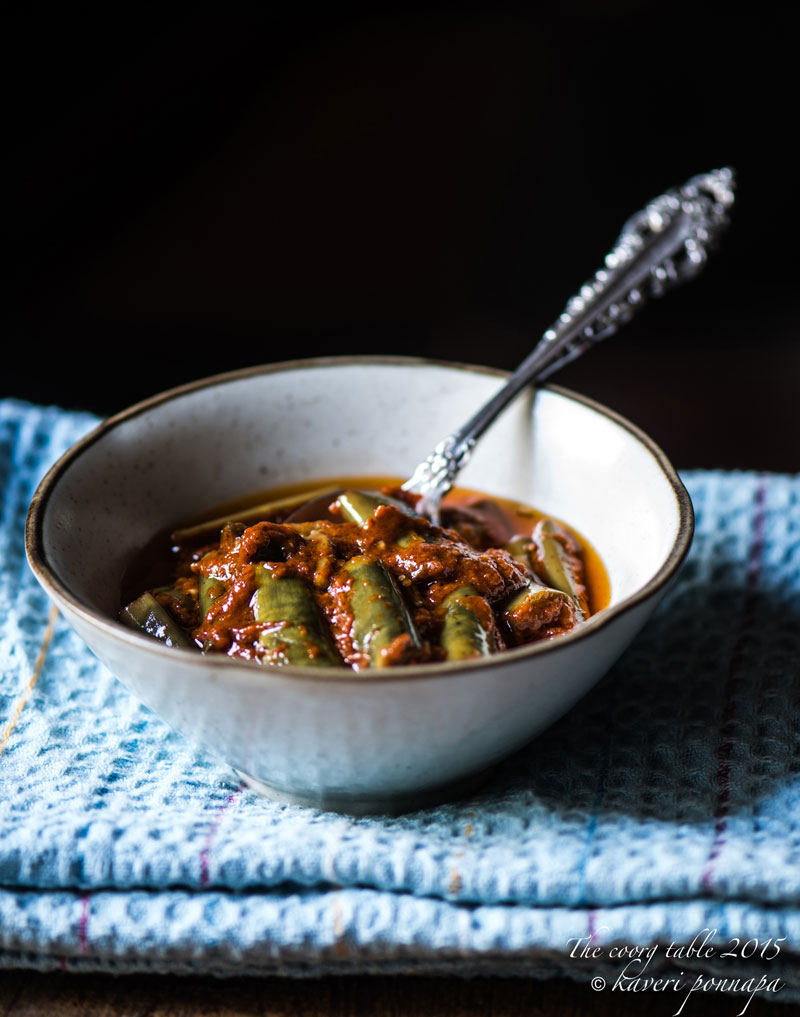
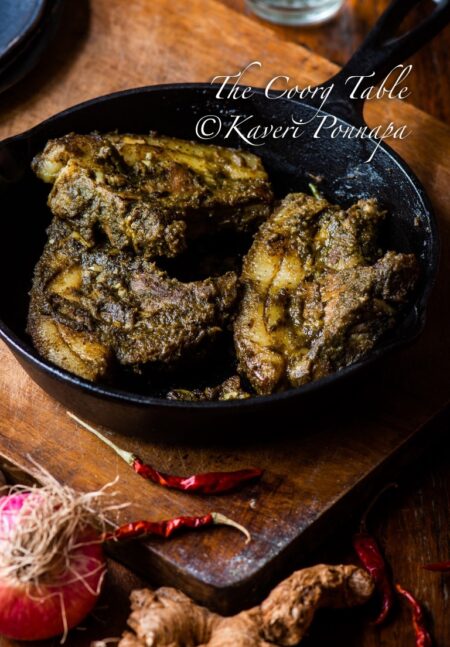
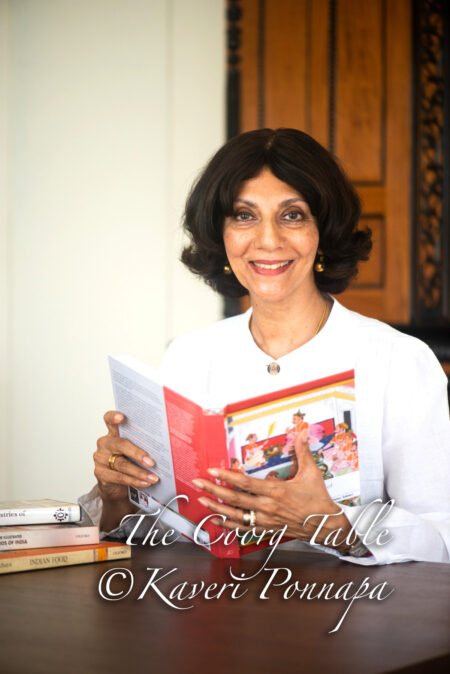
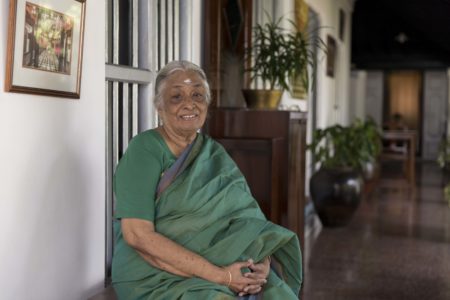
I’ve been hunting for a brinjal pickle recipe that would come somewhere close to the one my mother used to make, and which I had lost! This one certainly tastes almost identical to hers, and I’m so thrilled! It’s delicious.
I am revisiting your blog after many moons, and I must reiterate what, I think, I have already told you before…it is one of the most elegant and informative food blogs I have ever read. Wonderful.
Thank you for visiting, Indu, and for your appreciation. I’m so glad that you like the pickle, and if it tastes like your mother’s version, all the better! Do keep reading these pages, and I would love to hear from you. Warm wishes.Kaveri
Dear Kaveri…from 1978.to 1985, I had privilege of getting this pickle.regularly from my dear neighbour friends.” Poonacchas” in Jayalaxmi puram Mysuru.
Then my mom used to make them , of course from her memory. Later when she jotted down , it had its own version, nevertheless tasted very well.
I have my own version now… With small diversion from your recipe.. I use Ginger instead of garlic , and use jeera too. Rest same as yours
I treat it like a vege to be eaten over three to four days. Children who don’t or didn’t like ” Aubergines,,🤓” eat this preparation willingly
Hello Latha, thank you very much for sharing this story. A treat to have pickles from a neighbour, and how nice to be able to carry on the tradition, with your own additions.
You are right, even aubergine ‘haters’ love this mild pickle! Do keep reading. Warm wishes, Kaveri.
This recipe is a winner. Versatile, Tasty and definitely More-ish, it was loved by all the family. Thanks, Kaveri for posting this. Your photographs are brilliant too- I loved the old world charm of the utensils used.
Hi Anjana, thank you very much for your feedback. Delighted that your family enjoyed the pickle, this is one of my absolute favourites, it goes with everything. The pictures are pure teamwork, inspired by a love of kitchens of the past. Warm wishes. Kaveri
That I love all your recipes is a given, and I cannot wait to try out the brinjal pickle. However, what lends that extra edge are the photographs. The quality of pictures is brilliant, and the styling evokes a certain period in our lives – about twenty years ago. Keep it up!
It’s a simple, delicious pickle that has livened up many a breakfast and lunch for me, Marryam, I hope that you enjoy it too. Thank you for your kind words about the pictures and styling – I try to evoke the kitchens where I saw this food being created, year after year,while I was growing up: a blend of rustic tradition,well-worn vessels and implements with a bit of the modern asserting itself.To me it also has the timelessness of contemporary country kitchens the world over that will continue to be loved forever. Warm wishes.Kaveri
Hi Kaveri,
How do you make the brine? Sorry for asking such a stupid question. Also, you only use the brine to grind the spices?
thanks,
Soma
Hi Soma,
It’s not a stupid question at all – we all take a lot of things in recipes for granted. I use 2 tablespoons of rock salt for 1 cup of water. This is rather more than usual, but it gives you a lovely, intense saltiness, which is just perfect for grinding the spices and flavouring the pickle. Yes, you use ONLY the brine to grind the spices to a thick paste. Do not add any water. I hope this answers your queries, you are always welcome to ask questions. Good luck with the pickle, it’s delicious! Kaveri.
Hi Kaveri,
Thanks so much. I am loving all your articles and pictures. I brought Coorg honey, pork pickle, pork masala, kachampuli from India. I shipped it from Coorg to Calcutta and then brought it to the US. I am yet to try any of the recipes. I am definitely going to try the rice pulao and this brinjal pickle.
Soma
That sounds like a lot of fun, Soma. You’re a food lover after my own heart, that’s just what I do – carry cooing ingredients around the world and back again. The Neyi Kool and Bainay Para go very well together. Do let me know how they turn out. Warm wishes. Kaveri.
I’ll surely do that. I can almost smell the aroma from the rice and the spiciness from the pickle. I would aslo love to go to Coorg one day.
My favorite pickle..thank u for the recipe
Hello Jeevitha, I love this pickle too! It is so simple and delicious, and goes with everything. I’m glad you enjoyed it, the other recipes are very good too. Warm wishes.Kaveri.
Thank u so much for sharing this recipe with us .I am going to try it out one of these days .Once again thank u Kaveri
Hello Chitra, welcome to The Coorg Table! This pickle is utterly delicious, I’m sure you’ll enjoy it. Do try the other recipes too. Warm wishes. Kaveri
So nice of you!!! Thanks for sharing……..Thank you!!!
You are always welcome, Kaverappa! The pickle was a super hit, already set to become a classic at home and with friends. Warm wishes, Kaveri.